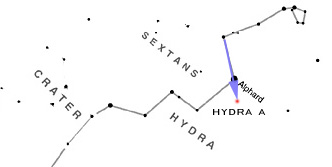


Liu consisted of the stars we visualize as the head of Hydra (Theta, Omega, Zeta, Rho, Epsilon, Delta, Sigma, and Eta Hydrae) but in Chinese astronomy it marked the head of the Red Bird of the South. First of these was Liu, also the name of the 24th lunar mansion. In Chinese astronomy, Hydra contained three constellations after which lunar mansions were named. But Apollo knew that the crow was lying, and punished the bird by placing him in the sky, where the water-snake eternally prevents him from drinking out of the bowl. When the crow eventually returned to Apollo it blamed the water-snake for blocking the spring. In this story, the crow was sent by Apollo to fetch water in the bowl, but loitered to eat figs from a tree. He slit open the body of the Hydra and dipped his arrows in its poisonous gall.Ī second legend associates the water-snake with the constellations of the Crow (Corvus) and the Cup (Crater) that lie on its back. Finally Heracles cut off the immortal head of the Hydra and buried it under a heavy rock by the roadside. Heracles called for help to his charioteer Iolaus who burned the stump of each head as soon as it was struck off to prevent others growing in its place. The crab is commemorated in the constellation Cancer. To add to Heracles’s worries, a huge crab scuttled out of the swamp and attacked his other foot, but Heracles stamped on the crab and crushed it.

The Hydra wrapped itself around one of his legs Heracles smashed at its heads with his club but no sooner had one head been destroyed than two grew in its place. Heracles rode up to the Hydra’s lair in his chariot and fired flaming arrows into the swamp to force the creature into the open, where he grappled with it. Its breath and even the smell of its tracks were said to be so poisonous that anyone who breathed them died in agony. Hydra lived in a swamp near the town of Lerna, from where it sallied forth over the surrounding plain, eating cattle and ravaging the countryside. In the sky, though, it is shown with one head only – perhaps this is the immortal one. Hydra reputedly had nine heads, the middle one of which was immortal. Hydra was thus the sister of the dragon that guarded the golden apples, commemorated in the constellation Draco. The Hydra was a multi-headed creature, the offspring of the monster Typhon and the half-woman, half-serpent called Echidna. First, and most familiar, the Hydra was the creature that Heracles fought and killed as the second of his famous labours. There is now also a male water snake in the sky, the small southern constellation Hydrus, introduced by Dutch navigators at the end of the 16th century. Aratus correctly used the feminine form, Ὕδρη (Hydra). Both names were originally given by al- Ṣ ūfī in his Book of the Fixed Stars ( AD 964).Įratosthenes and Ptolemy both called the constellation Ὕδρος (Hydros), which is the male form of the name but this water snake is actually female, so they were in error. Bode on his Uranographia atlas gave it the alternative name Unuk es Schudscha, from the Arabic unuk al-Shujā, neck of the serpent. Its only star of note is second-magnitude Alphard, a name that comes from the Arabic al-fard appropriately meaning ‘the solitary one’. Yet for all its size there is nothing prominent about Hydra. The total length from its westernmost boundary to the easternmost one is 102°.5. Its head is south of the constellation Cancer, the crab, while the tip of its tail lies between Libra, the scales, and Centaurus, the centaur. Hydra is the largest of the 88 constellations, winding over a quarter of the way around the sky. Origin: One of the 48 Greek constellations listed by Ptolemy in the Almagest


 0 kommentar(er)
0 kommentar(er)
